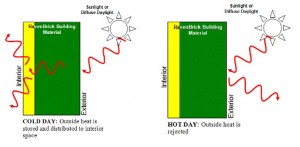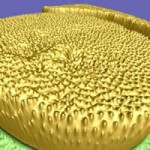Alex Davies posted a July 10, 2012 article on the Treehugger website about a smart window/wall system from RavenBrick. From the article (Note: I have removed links),
The RavenWindow from RavenBrick changes its tint in response to temperature, so it blocks sunlight entering a building after a set temperature has been reached. Combine it with a layer of insulating materials that store heat during the day and release it at night, and you’ve got the RavenSkin Smart Wall System.
Here’s a little more about the RavenWindow from the company’s Project Portfolio page,
RavenBrick has installed their RavenWindow product at the [US] Department of Energy’s National Renewable Energy Lab in Golden Colorado. This LEED platinum building was designed to use the most energy efficient products available. This installation, on the executive floor, is the first of three installations that will be done at NREL.
Then, here is the view of the tinted windows from the outside,
They do give a fairly simple explanation of the technology, from the company’s The Technology page,
RavenBrick’s smart window systems are changing the rules of energy efficent design by doing something that previous generations of building materials simply couldn’t: letting the sun’s heat into the building when you need it, and keeping it out when you don’t.
Our thermochromic filters utilize advances in nanotechnology, pioneered and patented by RavenBrick, to transition from a transparent to a reflective state in response to changes in the outside temperature. This transition allows a building to use the sun as a source of free heat on cold days and block solar heat effectively on hot days.
Davies’ Treehugger article offers some figures regarding savings (and another illustration),
The RavenSkin Smart Wall System promises to cut energy bills by as much as 30 percent, so it’s sure to offset the costs of installation (not listed on the RavenBrick website). The “infrared power system” doesn’t involve electricity, moving parts or wires, so it’s low maintenance, [sic]
I would have liked a little more detail. How did they derive the savings number, i.e., “by as much as 30%”? Also, is there any data from the US Dept. of Energy? At any rate, this product is due to reach the marketplace sometime in 2013.
I last mentioned RavenBrick and their windows in my Aug. 5, 2009 posting. In my Sept. 7, 2011 posting about the US Dept. of Energy, I focussed on smart window research being done at their Lawrence Berkeley National Laboratory (Berkeley Lab).




